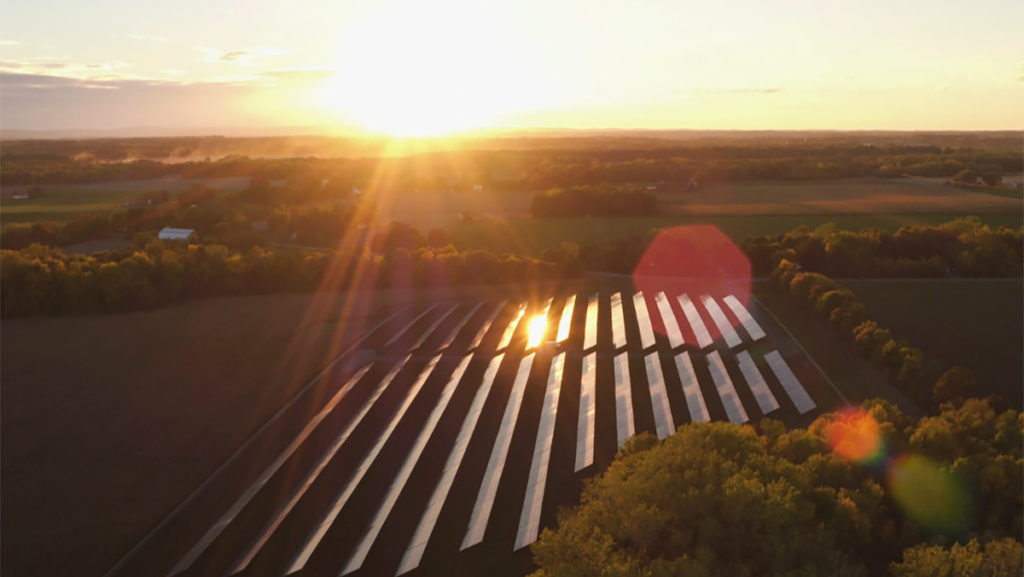Ithaca College announced March 30 that as of February 2018, all of the college’s electricity supply, currently 33,000,000 kWh annually, has been transitioned to clean energy and will only be purchased through Green-e certified wind farms.
The Green-e certification program certifies the college’s power claims and prevents power suppliers from overselling their allowed supply. This transition completely eliminated the college’s scope two carbon emissions — which are defined as emissions that come from purchased electricity, steam or other forms of energy generated by the college, according to the college’s announcement — in accordance with the goals set by the Climate Action Plan.
The College’s Climate Action Plan was written by the President’s Climate Commitment Committee and approved by the Board of Trustees in 2009. In August of 2017, the Department of Energy Management and Sustainability and President Shirley M. Collado called for a Climate Action Plan Reassessment Team to reevaluate the plan and see where the college could move forward. The suggestion to switch to renewable energy came from the Climate Action Plan Reassessment Team, which included a mix of approximately 12 professors and employees of the college, and some additional students.
Buying electricity through wind farms will offset 7,000 metric tons of carbon dioxide emissions, which account for approximately 35 percent of the college’s total carbon footprint.
Greg Lischke, director of energy management and sustainability in the Department of Energy Management and Sustainability, said the move to renewable energy will cost about $35,000 a year and is coming from the department’s budget. Lischke said he has been working on reviewing and improving the Climate Action Plan since he first arrived at the college in June 2016.
“I wanted to wrap up the first five years,” he said, “We were going to look at how did we do in the first five years and what do we focus on in the next 10, and how do get from here to there? The biggest question I’m hoping to answer is if 2050 is still a viable goal or can we move it up?”
Lischke said he is hopeful the college can reach carbon neutrality before the year 2050, the original goal set by the Climate Action Plan. The college is now 45 percent carbon neutral, with 35 percent of the college’s energy from the wind farms and 10 percent of the college’s energy from the already–implemented solar farm in Seneca, New York. These reductions in greenhouse gas emissions will go toward offsetting scope one emissions — heating and natural gas emissions — and scope three emissions, which are from activities such as traveling, Lischke said.
“I think when you look at renewable energy from the electricity side, that’s a lot easier to solve,” he said. “The scope three emissions that people use when they drive to and from classes, when we go to conferences or academic programs off campus, those are a little more challenging to offset — we’re still a fossil fuel–based economy.”
Rebecca Evans, campus sustainability coordinator in the Energy Management and Sustainability department, is a member of the Reassessment Team and said the team’s main goal is to look at new ways the college could reach carbon neutrality by or before 2050. Evans said the original Climate Action Plan stated that the plan needed to be revisited and assessed every five years. Evans said that it has not been updated as often as it should.
“It needed to be updated,” Evans said, “Things have changed, different energies have become a lot less expensive, and certainly the culture at the college has changed.”
Susan Swensen Witherup, professor in the Department of Biology, was involved in the original writing of the Climate Action Plan and is a member of the reassessment team. Witherup said she agrees that the Climate Action Plan needs to be updated because the plan involves evolving topics.
“Climate Action Plans get out of date really quickly because things happen on campuses and there are new buildings, there are new people, there are new prices for electricity and energy,” Witherup said. “Things change. … It’s a really fast moving area so if you’re not constantly revisiting that plan it gets stale quickly.”
Witherup said she felt that without the reassessment team, it is hard to say whether the college will met the 2050 carbon neutrality goal. However, she is hopeful that the college will be carbon neutral before 2050.
“I think continued work on energy reduction is probably what’s going to happen,” Witherup said. “These are often times behind-the-scenes projects that don’t see the light of day, like changing bulbs to LED bulbs or changing the fans in CNS to be more efficient fans … those are things don’t get a lot of notoriety because they are not very sexy.”
Those little changes, Lischke said, can make a big difference. Lischke said that when the library changed the lights to LED light bulbs in the summer of 2016, there was a 20 percent reduction in energy use.
Lischke said he is hopeful that more changes and updates to the plan are on the way. He mentioned looking into more geothermal buildings to help eliminate scope one emissions.
Lischke said he believes the college is on track to exceed the 2050 goal.
“I believe Ithaca College can reach it before 2050,” Lischke said. “It will require support by students, faculty, staff, senior administration, the whole nine yards.”








